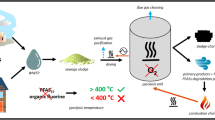Abstract
This study reports on the mobility and retention of trace elements in cassiterite tailings at the inactive Jumna mill, tropical north Queensland. Since the 1980s, the uncapped tailings have developed laterally discontinuous Fe-rich hardpans, which are located in the higher parts of gently sloping tailings masses and at the top (<50 cm) of the tailings piles. Hardpan-cemented tailings comprise thin layers (typically ∼0.2–2 mm thick) of HFO (hydrous ferric oxides) and sulfate efflorescences cementing tailings grains. In comparison to the tailings, the hardpan-cemented tailings contain significantly higher median As, Ca, Cd, Co, Cu, Fe, In, Mn, Mo, Stotal, Th, U, Y and Zn values. Partial leaching studies of tailings and pond water analyses indicate that wetting and acidification of Fe-cemented tailings removes significant proportions of trace elements into pore and surface waters. Tin shows no mobility due to the presence of weathering-resistant cassiterite (SnO2) and, As and Pb display limited mobility possibly due to their coprecipitation with jarosite-type phases and HFO materials at the top of the tailings profile. By contrast, the trace elements Cd, Ce, Cu, La, Ni, Pb, U and Zn display the greatest mobility, possibly due to their incorporation in soluble sulfate efflorescences and sorption onto mineral and HFO surfaces. Hence, the Fe-rich hardpans do not protect the sulfidic tailings from further oxidation nor do they cause permanent sequestration of trace elements.




Similar content being viewed by others
References
Agnew M, Taylor GF (2000) Development, cycling and effectiveness of hardpans and cemented layers in tailings storage facilities in Australia. In: Grundon NJ, Bell LC (eds) Proceedings of the fourth Australian workshop on acid mine drainage, Australian Centre for Mining Environmental Research, pp 157–169
Ashley PM, Craw D, Graham BP, Chappell DA (2003) Environmental mobility of antimony around mesothermal stibnite deposits, New South Wales, Australia and southern New Zealand. J Geochem Exploration 77:1–14
Blowes DW, Reardon EJ, Jambor JL, Cherry JA (1991) The formation and potential importance of cemented layers in inactive sulfide mine tailings. Geochimica et Cosmochimica Acta 55:965–978
Boulet MP, Larocque ACL (1998) A comparative mineralogical and geochemical study of sulfide mine tailings at two sites in New Mexico, USA. Environ Geol 33:130–142
Bureau of Meteorology (2006) Climate averages for Herberton, Queensland. http://www.bom.gov.au/climate/averages/tables/cw_031029.shtml
Chermak JA, Runnells DD (1996) Self-healing hardpan barriers to minimize infiltration of water into sulfide-bearing overburden, ore, and tailings piles. Tailings and Mine Waste ‘96, AA Balkema Publishers, pp 265–273
Craw D (2003) Geochemical changes in mine tailings during a transition to pressure–oxidation process discharge, Macraes mine, New Zealand. J Geochem Explor 80:81–94
Dash PH, Barker RM, Morwood DA, Culpeper LG, Lam JS (1991) Mineral occurrences—Atherton 1:100 000 sheet area. Queensland Resource Industries Record 1991/14. Department of Resource Industries, Brisbane
Dill HG, Pöllmann H, Bosecker K, Mwiya S (2002) Supergene mineralization in mining residues of the Matchless cupreous pyrite deposit (Namibia)—a clue to the origin of modern and fossil duricrusts in semiarid climates. J Geochem Explor 75:43–70
Ettner DC, Braastad G (1999) Induced harpan formation in a historic tailings impoundment, Røros, Norway. Tailings and Mine Waste ‘99, AA Balkema Publishers, pp 457–464
Garrad PD, Bultitude RJ (1999) Geology, mining history and mineralisation of the Hodgkinson and Kennedy Provinces, Cairns Region, North Queensland. Queensland Minerals and Energy Review Series, Department of Mines and Energy, Brisbane
Gieré R, Sidenko NV, Lazareva EV (2003) The role of secondary minerals in controlling the migration of arsenic and metals from high-sulfide wastes (Berikul gold mine, Siberia). Appl Geochem 18:1347–1359
Gilbert SE, Cooke DR, Hollings P (2003) The effects of hardpan layers on the water chemistry from the leaching of pyrrhotite tailings material. Environ Geol 44:687–697
Harris DL, Lottermoser BG, Duchesne J (2003) Ephemeral acid mine drainage at the Montalbion silver mine, north Queensland. Aust J Earth Sci 50:797–809
Holmström H, Öhlander B (2001) Layers rich in Fe- and Mn-oxyhydroxides formed at the tailings-pond water interface, a possible trap for trace metals in flooded mine tailings. J Geochem Explor 74:189–203
Lin Z, Herbert Jr RB (1997) Heavy metal retention in secondary precipitates from a mine rock dump and underlying soil, Dalarna, Sweden. Environ Geol 33:1–12
Lottermoser BG, Ashley PM (2005) Tailings dam seepage at the rehabilitated Mary Kathleen uranium mine, Australia. J Geochem Explor 85:119–137
McGregor RG, Blowes DW (2002) The physical, chemical and mineralogical properties of three cemented layers within sulfide-bearing mine tailings. J Geochem Explor 76:195–207
McGregor RG, Blowes DW, Jambor JL, Robertson WD (1998) The solid-phase controls on the mobility of heavy metals at the Copper Cliff tailings area, Sudbury, Ontario, Canada. J Contam Hydrol 33:247–271
McSweeney K, Madison FW (1988) Formation of a cemented subsurface horizon in sulfidic minewaste. J Environ Qual 17:256–262
Moncur MC, Ptacek CJ, Blowes DW, Jambor JL (2005) Release, transport and attenuation of metals from an old tailings impoundment. Appl Geochem 20:639–659
Morin KA, Hutt NM (1997) Environmental geochemistry of minesite drainage. MDAG Publishing, Vancouver
NWQMS (National Water Quality Management Strategy) (2000) Australian and New Zealand Guidelines for Fresh and Marine Water Quality. Paper No. 4. Australian and New Zealand Environment and Conservation Council, Agriculture and Resource Management Council of Australia and New Zealand, Canberra
Stewart BM, Lambeth RH, Williams BC (1993) Factors controlling the release and attenuation of contaminants in a sulfidic tailings impoundment. In: Proceedings of the 10th annual national meeting of the American Society for Surface Mining and Reclamation, pp 218–235
Whitney G, Esposito KJ, Sweeney KN (1995) Mineral reactions in a Colorado mine dump: implications for remediation in arid and semi-arid environments. In: Proceedings of the 12th annual national meeting of the American Society for Surface Mining and Reclamation, pp 577–586
Acknowledgments
An anonymous reviewer is thanked for a cogent review of the manuscript.
Author information
Authors and Affiliations
Corresponding author
Rights and permissions
About this article
Cite this article
Lottermoser, B.G., Ashley, P.M. Mobility and retention of trace elements in hardpan-cemented cassiterite tailings, north Queensland, Australia. Environ Geol 50, 835–846 (2006). https://doi.org/10.1007/s00254-006-0255-8
Received:
Accepted:
Published:
Issue Date:
DOI: https://doi.org/10.1007/s00254-006-0255-8




